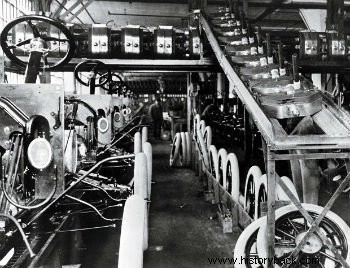The Second Industrial Revolution was born with the scientific and technological progress that took place in England, France and the United States, around the second half of the 19th century.
Summary of Key Features
Between 1850 and 1950, the search for discoveries and inventions was long, which represented greater comfort for the human being, as well as the dependence of countries that did not carry out the scientific and technological or industrial revolution.
The whole world started to buy, consume and use industrialized products manufactured in England, France, United States, Germany, Italy, Belgium and Japan.
The discovery and use of new energy sources - oil (in the combustion engine), water (in hydroelectric plants), uranium (for nuclear energy), revolutionized industrial production even more. The list of inventions and discoveries is huge, which represented greater comfort for the human being.
In the search for greater profits, the specialization of work was taken to the extreme, production was expanded, starting to produce articles in series, which reduced the cost per unit.
Assembly lines emerged, conveyor belts through which the parts of the product to be assembled circulated, in order to streamline the process.
The Ford automobile industry, owned by businessman Henry Ford, established in the United States, was the first to make use of the treadmills that carried the car's chassis throughout the factory.
The workers assembled the cars with the parts that arrived in their hands on another conveyor belt. This method of rationalizing production was called Fordism.
 Fordism
Fordism
This form of production integrated the theories of the North American engineer Frederick Taylor, taylorism, which aimed to increase productivity, controlling the movements of machines and men in the production process.
This entire revolution led to the emergence of large industries and the generation of large economic concentrations, which formed the holdings , trusts and cartels .
Inventions of the Second Industrial Revolution
Among the many discoveries and inventions made during the Second Industrial Revolution are:
- new steel manufacturing processes , allowing its use in the construction of bridges, machines, buildings, rails, tools etc;
- technical development of production ofelectricity;
- invention of the incandescent lamp;
- emergence and advancement of means of transport (expansion of railways followed by the inventions of the car and the plane;
- invention of the media (telegraph, telephone, television and cinema );
- advancement of chemistry, with the discovery of new substances; the discovery of the multiple use of oil and their derivatives as a source of energy and lubricants; the emergence of plastics; development of weapons such as the cannon and the machine gun; the discovery of the explosive power of nitroglycerin etc;
- in medicine came antibiotics , the vaccines , new knowledge about diseases and new surgical techniques.
To know everything about the Industrial Revolution see the articles :
- Industrial Revolution
- English Industrial Revolution
- First Industrial Revolution
- Third Industrial Revolution
- Phases of the Industrial Revolution
- Causes of the Industrial Revolution
- Consequences of the Industrial Revolution
- Industrial Society
- Industrialization
- Industry
- Queen Victoria
- Questions about the Industrial Revolution
